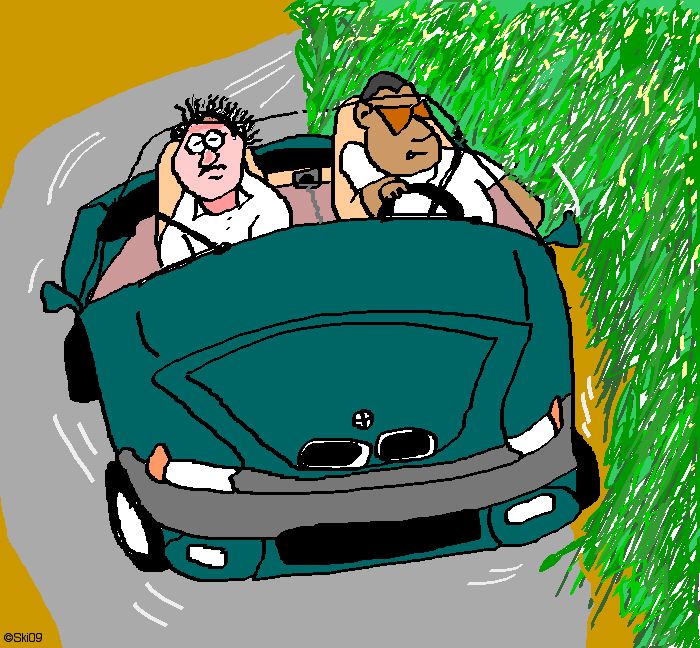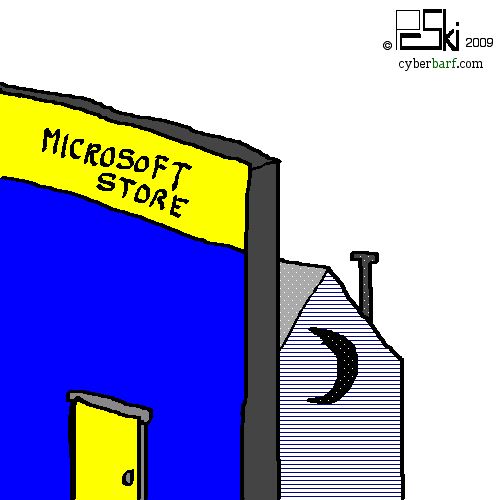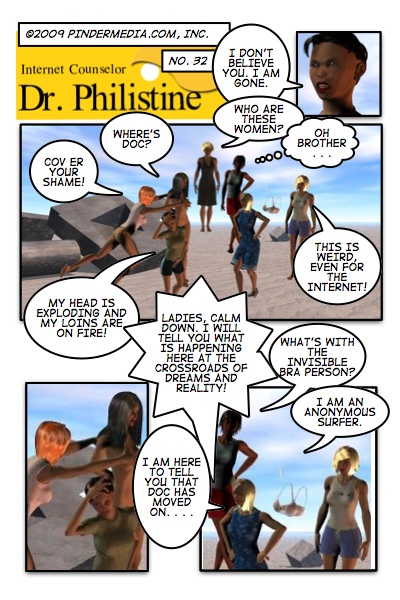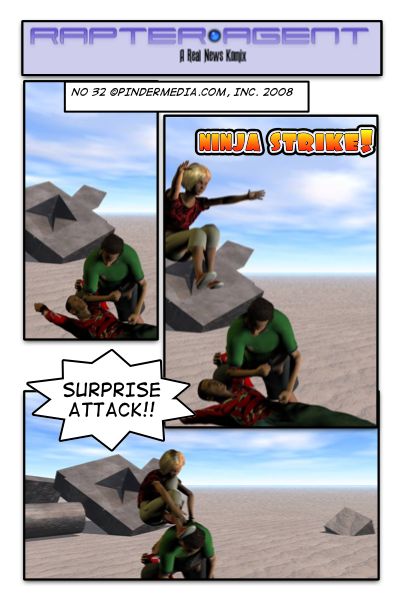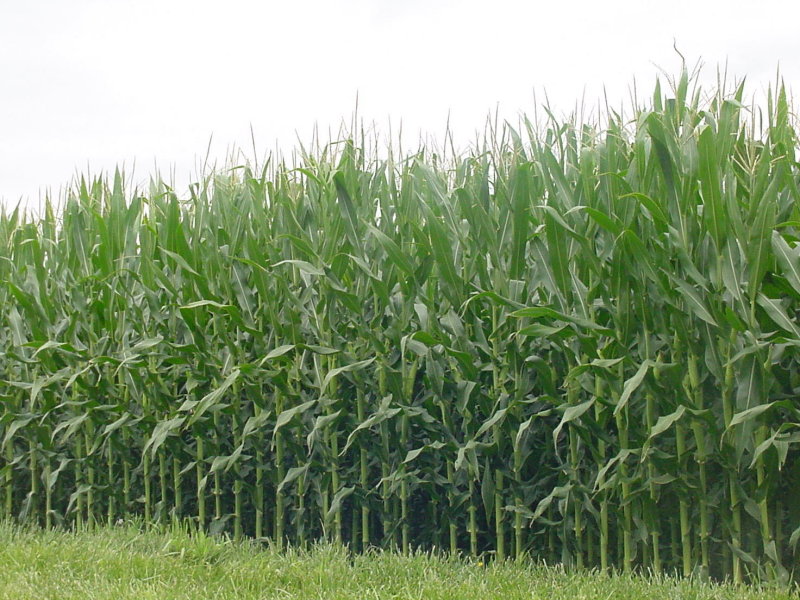
CYBERBARF 9.2 FARM (re) FRESH EDITION SEPTEMBER, 2009
|
cyberbarf9.2 IN THIS ISSUE EXAMINE THE NET WAY OF LIFE RIDERS OF THE CORN FARM TECH iTOONS NEXT CHALLENGE REAL NEWS KOMIX WHETHER REPORT SPORTS COMPLEX |
 |
 |
 |
|
cyberbarf RIDERS OF THE CORN ARTICLE You could have had a classic Doors tune on the radio, ripping through the uncovered convertible as it zipped down the flat asphalt back roads of the Midwestern farm land. Instead, we had the Miss Garmin GPS voice telling us to “turn left, right, turn left, right, turn over . . .” in a rambling nervous breakdown fury of a woman scorned at each intersection along the Lincoln Highway. Town after farm town on a Friday afternoon, pay day for most, were more desserted than old Western movie ghost towns. For all the hype the past five years about the three fold increase in farm commodity prices (especially corn and soybeans), the new wealth has not trickled down to the farm communities that help produce the actual produce. Many communities appear to be hanging on by a thread. It may have to do with corporate farms, where an absentee megafirm owns the land and tenant farms the acreage to its locust like work force that transverse the plains like some sci-fi horror film from the 1950s. It may also have to do with the structure of American finance, where the commodity prices do not accurately reflect the real prices paid to the independent farmers. When corn and soybean prices skyrocketed under the guise of the ethanol scam, many farmers quit the farm set-aside programs (where the government paid them not to plant) because they could make more money being actual farmers. But in the time period of laying fields fallow, the cost of producing commodites (hybrid seeds, chemical fertilizers, gasoline) had also doubled or tripled in cost. The humble tiller was in another economic Catch-22: to plant or not to plant. The financial muscle of the Midwest farm belt was the creation of the futures contract. This gave stability and standardization to local crops being sold and processed at a national level during the American Industrial revolution. The win-win concept was that farmers, who needed cash or capital in order to plant their annual crops, could sell their crops before harvest to buyers for delivery at a future date. The price bargained for allowed the farmer to lock in his sales price and the buyer (processor of the food stuffs) to lock in a ceiling of its future production costs. The farmer could take his future sales contract to the bank and get a loan to operate his farm for another year. The only wild card in the formula was supposed to be Mother Nature. A good growing season with high yields could mean that over all crop prices would fall under the terms of oversupply to demand. A bad growing season would mean that crop prices would rise based upon a shortage of supply. But for the one to one future contract holders, it was irrelevant to what the fall delivery prices would be because they had already agreed to the price in the spring. The only issue the farmer had to complete the deal was to deliver the exact amount of corn or beans the buyer purchased in the contract. If the farmer was short, he would have to fill the contract at the local grainery at the current market value, thus cutting into his budget and profit margin. If the farmer had excess yield, then he could sell the over bushels to the farm grain elevator operator thereby increasing his profit margin. At the same time, buyers may decide not to accept delivery of the contract goods from the farmer. As a result, they would sell their delivery contracts in the secondary market to other food manufacturers. As the current market value of corn or beans would fluctuate during the season, the buyer's delivery contract could increase or decrease in value. A food company may have more delivery contracts than they actual need to meet production requirements as a form of insurance that in down years, they had enough supply to operate (at most likely a cheaper fixed cost than at final market rates). But the financial system quickly had a third player in the mix. The speculator became the active market maker for secondary uses of these farmer and food manufacturer's futures contracts. Speculators were willing to take these contracts and actively trade the actual commodities against the delivery dates in order to allegedly stabilize the current market value of the real crops in the fields. But as in human nature, speculation culled rumor, gossip, prediction and fear with each weather report, which would cause crop prices to bounce like ping pongs against the daily limits (market imposed stops in the rise or fall of a price). The speculators suddenly found themselves actively buying and selling contracts in a furious pace which made some very big winners and corresponding big losers (as the idea of trading contracts was a zero sum game). But at some point, these gamblers found themselves with a limited supply of chips (futures contracts). Besides, the concept of playing hot potato with these delivery contracts when they ended was fraught with ire if a speculator forget to sell his last contract and wound up the next day with 1,000 bushels of corn poured out on his front lawn. So the speculators created a new instrument, an “options” contract giving speculators the “option” of purchasing commodity contracts at their future maturity date for delivery. of the underlying commodity. In this new options world, the speculators did not need access to the actual farmer-buyer delivery contracts to create a market. They just created this new market of securities out of thin air. And there was no limit to the amount of contracts a speculator could write and sell, because in the end the speculator need not deliver the actual products; the rules were written that traders could settle up at the end in cash payments. So the options pit became the place where the big money players rolled the dice, and the old futures contracts for corn or soybeans became merely a prop in the new financial world. The options prices then became the new standard structure for setting the “cash” commodity prices, which in turn affects the grain elevator prices paid to the farmer. Recently, farmers got the double whammy of higher demand by ethanol plants (who themselves were feasting on huge government subsidies in order to produce fuel at a higher cost than normal gasoline or diesel fuels) and rapid speculation on commodity prices based on the spike in crude oil speculation. The result was that the average American was suddenly getting hit with skyrocketing food costs at their local grocery stores. Even though the Commerce Department said there was a period of no true price inflation, the average consumers check out receipt showed at least a third more being paid for the same food and products in their shopping carts. Farmers were getting pinched at the grocery stores, too. Some farmers found themselves leveraged up based on these rising factors since the banks did not look at the underlying collateral as closely as one might have in leaner times. Just like housing, there are boom and bust cycles in the farm industry. The cost of processed food stuffs was greater than the increase in farm prices, leaving the farmer's projected budget out of synch with reality.
So those were the thoughts as we sped down the back roads of Northern Illinois, through the tall stands of corn rows, broiling under the late July sun. A wet, cool season has allowed thick, richly green fields to tower over us. However, we found out at local farmer's market, that the wet weather was fine to a limit. What the corn needed was hot and humid conditions in order to sweeten. This had not occurred, so the illusion of a bumper crop could be a looming time bomb for the average farmer. In addition, the ethanol fad caused a lot of farmers to change the type of corn they planted; which is yielding less bushels for actual food processing companies - - - and consequently, raising the cost of food at the grocery stores across America. Setting national policy without any common sense analysis is one thing; forcing a green platform without thinking about the law of unintended consequences in order to make a political statement is almost criminal behavior. Independent studies have shown that there is no nutriential difference between organic or normal food products. Organic brands merely cost more, even though the producers use no expensive chemicals. Conspiracy theorists believe that the whole “green” movement is another scam to give political insiders increased profit margins at the expense of the average American family.
|

|
cyberbarf FARM TECH ARTICLE The first cultivation was man poking a seed into the ground with a stick. The act of farming has not changed since that first garden. What has changed has been the methods to grow crops. From sticks, to tools like hoes, to pulling a stick through a field to make planting rows, to the revolutionary metal plow pulled by animal stock, to the modern mechanical tractor-tiller-harvester machines. Commercial farming has always been a gamble. Like all casinos, the odds are stacked in favor of the House, in this case, Mother Nature held all the wild cards. A farmer would have to content with endless variables: no rain, too much rain, wind or hail damage, too much heat, not enough heat, bad moisture levels, insect damage, oe weeds. This constant battle against the elements was all for the exercise of increasing the number of bushels of product per acre (the yield). For example, adding 10 bushels yield to a 1000 acre farm could add up to the farmer's entire profit margin for the season (adding $30,000 to the revenue line in the budget). On the flip side, a loss of 10 bushels per acre could spell an operating loss to the farmer. Technology now plays an increasingly important role in modern farming. High tech is trying to take as much guesswork out of the variable equations, cut costs through more efficient crop management, and better forecasting so farmers can have a better idea what their yield will be, and how much their fields will be worth at the end of the season. Precision farming is the new method. It contains various high tech approaches to farming: global positioning systems, harvest monitors, sprayer control systems, and chemical analysis. A farmer's field is not just a plot of dirt; it is a complex eco-system. Before even planting, a modern farmer can take soil samples of his field to determine what plant nuitrional deficiencies exist and buy the appropriate fertilizers. In the past, farmers merely bought enough chemical fertilizer for the amount of land they tilled; they would turn on the tank valves and run through the fields spraying whatever came out of the tank. But with precision accuracy, and GPS mapping systems, a modern farmer can put together a detailed soil survey of his land and pinpoint what fertilizers, insecticides or other materials need to be applied instead of the blanket approach in the past. This precision soil analysis saves money because the farmer need only buy what he will actually need to spray on his fields. The soil analysis and the long term weather forecasts can play roles in what a farmer will plant in the fields. Old farmers found that a three crop rotation was the best method for restoring the soils to proper planting conditions. The advent of chemical fertilizers to replace the nuitrients robbed by plants from season to season lessen the aspects of crop rotation. But some farmers still insist on some form of field rotation (probably to save fertilizer costs). But just as important (and expensive) is the type of seed the farmer will use each year. Major seed manufacturers use extreme high tech approaches to make hybrid seeds that can resist insects, pathogens, drought. The importance of seed technology is never as great as it is today: farmers may have to sign contracts to use the seed for planting only (with no fields set aside to grow their own seeds for the next season). Smart spraying is another advance for the industry. Sensors can monitor the soil conditions of the land while the farmer traverses the rows. Monitoring software can analyze what the soil conditions are and adjust the trailing spraying equipment to apply the correct amount of chemical. So a farmer can put variable levels of spray on a single field which is dramatically more efficient than with non-variable equipment sprayers. There are also weed control sensors which distinguish between weeds and crop stems when applying weed killer sprays. Automatic planting machines can calibrate the speed of the tractor and release the appropriate amount of seeds into the plowed rows which creates better plant spacing and growth potential in the fields. A farmer's tractor cab now has a computer workstation. The display monitor in the cab can show the GPS maps for his lands, the rate control for the application being applied behind the tractor, it can gather, store and analyze information from tractor sensors (such as moisture levels, soil factors, etc.). This tractor information can be downloaded into laptop farm management software programs that can give the farmer a real time sense of how well his crops are doing in the field. He can also use various models (market price, weather forecasts) to determine the next course of action in managing his fields, including the important step of determining when the best time to harvest the fields for the best yields. Every ounce of sweat equity could be lost if a farmer cannot get his crops safely out of the fields and into the grain elevators. The modern farmer is now part computer data processor, part business software engineer, part market speculator-analyst. He has to have modern high tech skill sets in order to compete, especially with the large corporate farm operations that have been buying up the small family farmsteads for the past several decades. The U.S. Department of Agriculture predicts that overall farm income in the United States will fall 38 percent this year. Only the most efficient farm operations can survive the wild swings in crop market prices.
|

 |
THE STEAM PUNK SPECIAL EDITION featured new Music from Chicago Ski & the (audio) Real News: (mp3/4;14 length) |
|
cyberbarf iTOONS
|
|
THE NEW CYBERBARF TEE-SHIRT IS HERE AT THE PINDERMEDIA.COM STORE!
THE INTERNET ZOMBIE T-SHIRT IS ON SALE NOW.
|
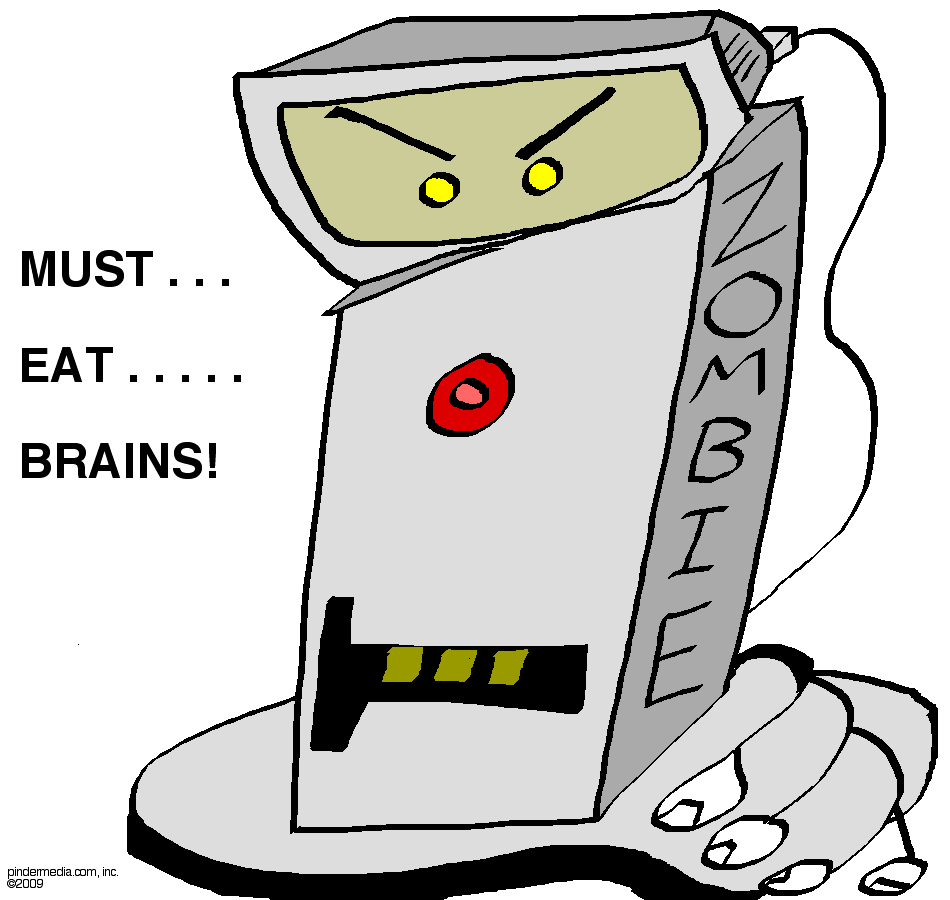 |
 |
|
cyberbarf NEXT CHALLENGE PRODUCTION BLOG As we stated in last month's edition, the current Real News Komix, Dr. Philistine and Rapter Agent, are in the process of ending their runs this year. Plans are in the works to add a new comic series when those series conclude four months from now. All the final strips have been completed as each series will conclude with Number 35. It is hard to believe that these serials have been running for three years. Now, the original plan was to go backward in the production technology and hand-draw any new comic strip for this site. Dr. Philistine and Rapter Agent were created by messing around with a new graphic 3D program, Poser, three years ago. Since most iToons are drawn on a computer (in a paint program), we thought it might be retro to go back in time to hand drawn creations. Going through his personal library, Ski thinks the last fully hand drawn comic he did was in 1994, Hi-Tech Man. Part of the joke of that comic was that the secret school technologist who saves the day was crudely hand drawn in the least computer tech way possible. Speaking of possibilities, if things do not happen on schedule, maybe Hi-Tech Man will meet its digital debut on this site (it was only published in paper form). There has been no plans to re-vive those characters in a new strip. Going back to a hand-drawn strip could be less labor intensive on the manipulation of elements in the computer programs. At least, in theory. Back to the replacement series: the first notion was to draw a one panel, computer life cartoon, mixing in the current foibles of an average computer user and technology that constantly tests his will power. No real title to this series was formalized; but five panels were roughed out for review. (Over the years, Ski has found that in order for him to be creative and not get lost by tangental deadlines like work in the real world, he has to finish a long run of strips in order to stay ahead of the game. Example, one early morning he did 36 Dog Leg strips for pindermedia.com.) A blank sheet of paper, an ink pen, an idea . . . . that's all that is needed to start and finish the project . . . . right? . . . . right? Yeah, right. There is a deep canyon character flaw in Ski; he has a habit of doing things the hard way in order to re-create the visions he wants to throw out their in cyberspace. So a hand drawn alternative comic is a nice conversation in his head, the dark matter has vollied back a cannon ball over the net of doing a more complex 3D strip. Now, in your own work space, the average person dealing with an easy (but necessarily lazy) way out over a hard (but necessarily HARD) way to accomplish something, the average sane person would choose the former. Now, the “hard way” imposes the education, experimentation and execution of 3D graphic software packages which have only been used in their basic feature sets in the past. We think it is pretty clear that we computer savvy operators probably only use 10 to 20 percent of the total number of features imbedded in a computer program. Part of the issue is a higher knowledge curve to unlock the program's secrets. Another is time; time to set aside to master a complex computer program is also deviant taskmaster. So Ski outlined a basic storyline, rough sketched a few crude sets, and started to rudimentarily construct new 3D characters. the hardest part of learning a 3D graphics program is that you have to retrain your mind from 2D art work techniques to seeing you artwork in a 360 panorama. Some monkees banging out network scripts on a manual typewriters are too old or stubborn to change their ways. The same is true with cartoonists. So we are at another self-imposed deadline: four months to find a replacement(s) cartoon strip(s) for the readers.
|
|
cyberbarf
|
REAL NEWS KOMIX \ |
|
cyberbarf SPORTS COMPLEX COMMENTARY
“There is an innate killer instinct in me.” --- Jimmy Connors. Connors was a championship tennis player when tennis was a popular middle class sport. Twenty years later, tennis has fallen off the prime time schedule of sporting events that capture the hearts and minds (and sporting goods dollars) of the general public. But at one point in time, Connors was a celebrity - - - on news stand and magazine covers as one of the good player “bad boys” of the sport. Yes, the gentlemanly sport of tennis once had its prima donna brats who now tend to migrate toward professional football and basketball. All champions have a killer instinct or drive to succeed. It is a personality trait to do whatever is necessary in order to win. Be faster, stronger, bigger, quicker, smarter, more agile; train longer, harder, farther than the others. But nothing in this narrow mindset to the path of sports success screams out to be smarter than anyone else. Sports tend to have physical attributes which dominate over mental strategy. In football, you line up, hit an opponent, run the ball carrier down, and tackle them. Brute strength, repetitive instinct and physical speed can make up for slow recognition of a developing play. Coaches will tell young players that they can increase their skills at all those levels by increasing weight training, practicing hard, and going to “speed camps” to teach an athlete techniques to improve his quick sprinting ability (his 40 yard dash times). There was a time in the early 1900s, when radicals warned against the Military-Industrial Complex, the rise of the American industrial production base and a growing government military presence on a global stage. Today, some commentators decry the Sports-Educational Complex, or the over-emphasis of sports in children's lives. There is a direct corrolation between high school sports championships and declining ACT and SAT scores for that school. The simple formula is another of life's zero sum game: the more one practices athletics, the less time is available for the student to study. Less time studying equates to poorer overall test scores. Proponents of organized sports programs state that team building is a valuable life tool. It acclaimates a young man or woman into a structured work environment. It teaches core values of team work, strength (physical and mental), sportsmanship, following the rules, building up self-esteem, practice work ethic, and winning.The latter sometimes gets over-emphasized by sports stage parents who believe their son or daughter is the next professional player or Olympic gold medalist. The over-emphasis of unattainable goals at the expense of education study habits and skills will hurt the average student-athlete than the parents, principals and coaches will realize. Other nations across the globe have their students in classrooms for the full year: longer hours of study, harder subject matter, more learning skills, higher test scores. The relentless push for academic excellence is the other extreme of a academic spectrum, but how many high school runners get Olympic gold are set for life as compared with high-grade point average dean students with advanced degrees in medicine, engineering or computer science? When the inner city schools failed its student bodies, there was the general preception that the only way to get out of the urban ghetto was to be a talented entertainer (singer, dancer) or a star athlete. Academics had no place if the goal was to just get out of the housing projects in one piece. A talent agent could care less what your grade point average was if you could belt out hit singles or tape measure home runs. In fact, if you were not so smart, it was easier for the talent agents to gorge themselves on naive families. Then colleges became the unpaid farm systems for professional sports franchises. The student-athlete on scholarship was mostly in higher education to increase his chances on draft day to get a higher bonus and signing contract. The schools put blinders on the academics of star athletes in order to get their teams victories . . . to appease the alumni and booster clubs who are the cornerstone of most fundraising for universities. Athletes on scholarship with no desire to earn a degree effectively take away a desk for a qualified student who wants to earn a degree. It also dilutes the school's academic reputation (which is the value potential employers place on one's diploma upon graduation). The over-emphasis on student athletics has turned the institutions of higher learning into big money sports camps, with coaches being the highest paid employees on campus. Some coaches are millionaires because they can recruit enough athletic talent to compete for championships that alumni need for bragging rights at cocktail parties. It is a sad state when college presidents and trustees are more concerned about an infield turning a 6-5-4 double play than any player on the squad being able to multiply 6, 5, and 4 together. Burn out. That is the end game for most youngsters who have been put through organized sports programs since elementary school. Kids can no longer be just kids playing around in the neighborhood because of the weirdos and creeps that stalk children. But kids being pushed into athletics so hard and fast come to see their sports as not pleasure but work. And at everyone's point in their work life span, they get disillusioned by work. Balance is the proper response to the sports complex quandry. Realistic expectations of the young athletic. The core of a solid education with good grades as being more important than being a star athlete (because the odds of maintaining such excellence is less than winning a weekly lottery drawing.) And letting kids just be unorganized kids playing around, goofing off, once in a while for some relaxing temperance.
|
|
cyberbarf THE WHETHER REPORT |
cyberbarf STATUS |
| Question: Whether personal web sites will fade away to smart phone based graphic-text applications? |
* Educated Guess * Possible * Probable * Beyond a Reasonable Doubt * Doubtful * Vapor Dream |
| Question: Whether nationalized medical records data base administered by new federal health agencies will increase the quality of medical care in the USA? |
* Educated Guess * Possible * Probable * Beyond a Reasonable Doubt * Doubtful * Vapor Dream |
| Question: Whether ACT and SAT English test scores will decline in a direct relationship to the increase use of Twitter in high school students? |
* Educated Guess * Possible * Probable * Beyond a Reasonable Doubt * Doubtful * Vapor Dream |
